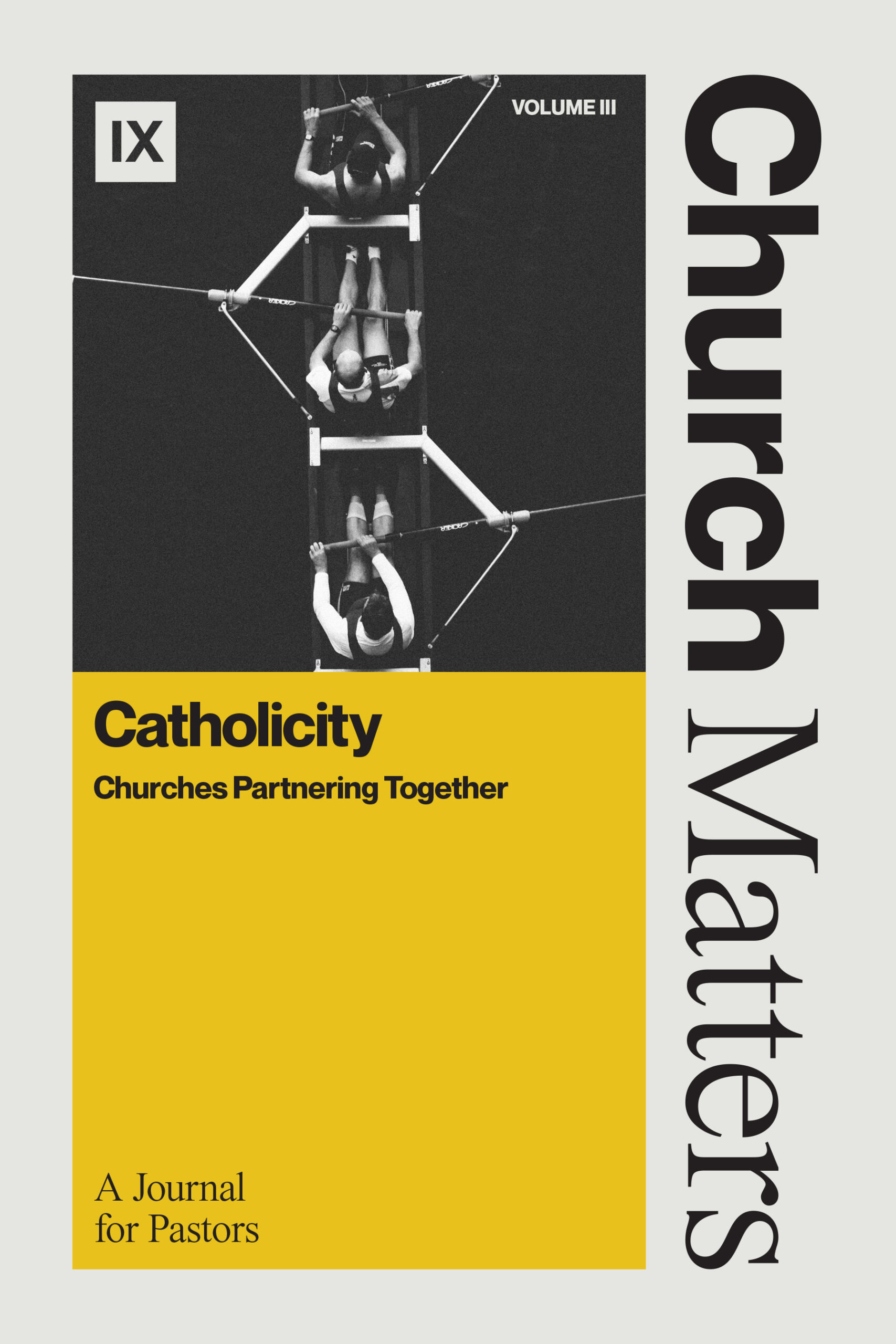What I’ve Learned from the Baptists
I was raised in the Episcopal church and was then ordained and now pastor in the Anglican Church in North America.[1] As such, I’ve always followed Jesus in the context of the episcopacy—that form of church governance where local churches are part of a diocese that a bishop oversees, and those dioceses are connected in a larger province under an archbishop.
One benefit of this church structure has been a heightened awareness of the larger church. When the bishop visited my church when I was growing up, we were all reminded that we were part of the Church, the people of God extending beyond local assemblies, where all Christians are united under one head, Christ (Eph. 1:22–23). A blessing of Anglicanism, at least for me, has been a thick catholicity. The episcopacy puts skin on the church universal.
As with any denomination, however, strengths can also be weaknesses. An unintentional consequence of thick catholicity can be thin congregationalism. The episcopacy can eclipse the ekklesia, in as much as the latter most commonly refers, in the New Testament, to a local gathering of Christians. It is a pity when this happens in Anglicanism because our English reformers, in the Thirty-Nine Articles, define the visible church as a local congregation:
The visible Church of Christ is a congregation of faithful men, in which the pure Word of God is preached, and the Sacraments be duly ministered according to Christ’s ordinance, in all those things that of necessity are requisite to the same.[2]
It has been my Baptist friends who have helped me think more deeply about the biblical form and function of the congregation—this “assembly of a local body.”[3] Though we have real differences—about polity and baptism especially—the independent or congregational structure of Baptist churches brings into sharp relief the role and potency of the church gathered.
Here are four things Baptists have taught this Anglican about ecclesiology.
Membership
First, Baptists have encouraged me to think more deeply about church membership. In the Anglican tradition, adults often become members of their local church when they’re confirmed by the bishop. But in the process of confirmation—at least in my experience—more emphasis can be placed on what Anglicanism is at large rather than what it means to be part of a local Anglican church. Baptists have shown me the biblical call for thick congregationalism, the skin of which is intentional membership.
If the visible church is a congregation, then how do we define it? Anyone who shows up on Sunday? What are its borders? Are they nebulous or clear?
Baptists I’ve interacted with strive to establish the what and who of the congregation by a robust membership process that seeks, following Paul, to define the visible church as a body of believers.[4] This process often involves candidates taking a multiple-week course, undergoing membership interviews with pastors, and agreeing to a membership covenant. It always assumes adult (believers) baptism. In short, it’s a process aimed at a converted congregation.
The positives of intentional membership are at least twofold. First, it’s biblical. Jesus’s vine and branches image, Paul’s body metaphor, as well the plethora of “one another” commands, all underscore the corporate and communal nature of Christianity (John 15:1–8; 1 Cor. 12:12–13; 1 Thes. 5:11). Intentional membership is a concrete way to lead Christians toward “welcoming one another,” “bearing with one another in love,” “serving one another,” and “stirring up one another to love and good works” (Rom. 15:7; Eph. 4:2; Gal. 5:13; Heb. 10:24).
Second, intentional membership is corrective, a welcome antidote to Western culture’s retreat from commitment. Covid and the normalization of remote work have only reinforced the disintegration of thick community. But it’s clear in the New Testament that we cannot mature as Christians without one another: “We grow up in every way into Christ,” Paul explains, when we are “joined and held together by every joint. . . when each part is working properly” and therefore “makes the body grow” (see Eph. 4:15-16). Thicker membership helps disciples grow up in Christ.
Conversion
Second, the Baptist practice of believer’s baptism encourages those of us who practice pedobaptism to think carefully about how we encourage and assess adult conversion. The 1662 Book of Common Prayer addresses the Godparents and congregation attendant upon an infant’s baptism as follows:
This infant must also faithfully for his part, promise by you that are his sureties (until he come of age to take it upon himself) that he will renounce the devil and all his works, and constantly believe God’s Holy Word, and obediently keep his commandments.[5]
And,
Ye are to take care that this child be brought to the Bishop to be confirmed by him, so soon as he can say the Creed, the Lord’s Prayer, and the ten Commandments . . . and be further instructed in the Church-Catechism set forth for that purpose.[6]
Those of us who practice infant baptism must take seriously the need to prepare children and young persons for confirmation, with their public profession of faith a necessary fruit attesting to conversion (Rom. 10:10). Conferring adult membership on persons baptized as infants who have not been confirmed or made a public profession of faith puts both those individuals and the local church at risk of being self-deceived.
Local Leaders
Third, Baptist churches with a plurality of elders have encouraged me to think strategically about raising up leaders within the local church for the local church. In Anglican practice, deacons and presbyters are presented by a local congregation to be ordained by a bishop. This is often a rigorous and useful practice. However, it can sometimes lead to local churches relying too much on the broader diocese to identify and raise up leaders.
The tie between the local church and ordination in Baptist polity encourages the local church to take a more active role in identifying and equipping church leaders. Anglican congregations may send ordinands off to seminary and affirm them in a process of discernment with the diocese. However, we also should be more intentional about how we—as local churches—create pathways for leadership development.
The Primacy of the Word
While my church’s sanctuary was nearing the end of construction, a Baptist friend touring it asked me, “Have you considered putting the pulpit in the center?” This would differ from the typical Anglican arrangement where the Lord’s Table sits at the center. His question raised another question in my mind: which is the central instrument of grace in the life of the local church, the Eucharist or the Word?
While in no way downplaying the sacraments, one of the achievements of the English Reformers was to recognize that if the doctrine of justification by grace through faith is the basis for salvation, and if “faith comes by hearing, and hearing through the Word of Christ” (Rom. 10:17), then the preaching of the Word must be reclaimed as central to the life of the church. “Grace is mediated,” explains Michael Jensen, “to the believer by God himself speaking in his Word. The only way to receive this Word is by means of the ears, by faith. . . . Thus, the Word must be preached if it is to be heard.”[7]
I cherish the holiness of sharing the Eucharist when we gather on Sundays. However, some so-called liturgical churches, perhaps especially Anglican ones, can prioritize the sacrament while allowing the sermon to become a short homily with little substance. My Baptist friends who emphasize a Word-centric ministry have challenged me to ask if I am creating space for the Spirit to work through the Word on Sunday morning.
Finally, I’m thankful that Christians are not saved by their denomination but by Christ. A healthy catholicity—where togetherness is rooted in our shared belief in the gospel—means that fellowship can be enjoyed between Anglicans, Baptists, Presbyterians, and more. We can sharpen each other, even by our differences. I’m so very thankful for all my Baptist brothers and sisters have taught me.
* * * * *
[1] For more about the Anglican Church in North America and how it relates to the Global Anglican Communion, see my article, “GAFCON IV: Lessons from a Communion in Birth Pains,” The Gospel Coalition, April 25, 2023. Access online: https://www.thegospelcoalition.org/article/gafcon-iv-lessons/
[2] Article 19 of The Thirty-Nine Articles of Religion, emphasis added
[3] “Congregation,” The Compact Oxford English Dictionary, 2nd ed. (Oxford: Clarendon, 1998), 315.
[4] Mark Dever, Nine Marks of a Healthy Church, 4th ed., 124, writes, “When you read the letters of Paul, it seems clear that Paul too wrote as if the churches were composed entirely of believers; thus he addressed them as saints.”
[5] The Book of Common Prayer: The Texts of 1549, 1559, and 1662, Edited with an Introduction and Notes by Brian Cummings (Oxford: Oxford University Press, 2011), 410-11, emphasis added.
[6] The Book of Common Prayer: The Texts of 1549, 1559, and 1662, Edited with an Introduction and Notes by Brian Cummings (Oxford: Oxford University Press, 2011), 414.
[7] Michael P. Jensen, Reformation Anglicanism: Experiencing Grace, Expressing Gratitude. The Reformation Anglicanism Essential Library, Volume 4 (Wheaton, IL: Crossway, 2021), 80.









